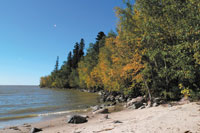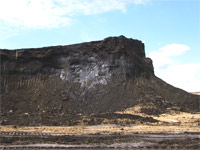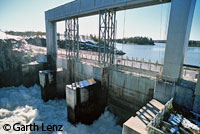
News |
- New 2011 Lake Winnipeg Action Plan
- Manitoba Plants Trees for Environment Week
- New Reality Checks 10, 11, 12, 13
- Manitoba Moose-hunting Cancelled
- Canada Tries to Hide Alberta Tar Sands Carbon Emissions
- Manitoba May Ban 'Cosmetic Pesticides'
- Underwater Bipole Still Alive, Says Ryan
- Tories Take-on Tariff - Ontario Green Energy Act Could Be Threatened
- B.C. Court Backs Bid To Protect Caribou
- Hydro Exports = "Manitoba's Oil"
- Export Deal Requires Keeyask Dam
- Manitoba Wildlands Posts 4 New Reality Checks
| New 2011 Lake Winnipeg Action Plan | 11 June 11 |
 The Government of Manitoba tabled Bill 46: The Save Lake Winnipeg Act June 2011 to protect Lake Winnipeg from excessive nutrient loading. It is expected to pass before the end of the legislative session in summer 2011.
The Government of Manitoba tabled Bill 46: The Save Lake Winnipeg Act June 2011 to protect Lake Winnipeg from excessive nutrient loading. It is expected to pass before the end of the legislative session in summer 2011.The act tightens rules on expanding hog farms and manure spreading, protects wetlands that filter out pollutants, and forces the City of Winnipeg to build a sewage treatment plant with a focus on phosphorus rather than nitrogen. Amendments to Manitoba's Crown Lands Act, Environment Act, Mines and Minerals Act, Planning Act, and Water Protection Act are listed in Bill 46. The introduction of Bill 46 came two days after release of a report, led by University of Regina biologist Peter Leavitt, that blames Manitoba crop and livestock production for at least half of Lake Winnipeg's phosphorus problem. The report says phosphorus loading must quickly be addressed on the lake to avoid uncontrolled algae growth and production of deadly toxins. The aim is to cut the amount of phosphorus in Lake Winnipeg in half, but no timeline for achieving such an objective is provided. "I'm frankly not so sure that can be achieved. That's going to require considerable lifestyle changes on the part of pretty much everyone in the watershed," said Gordon Goldsborough, a biology professor at the University of Manitoba. Any individual citizen, or representative of an organization, can make an oral or written submission to the Legislative Review Committee before the new legislation is passed. The Committee will sit at 6pm on June 13th, 2011 in Room 255 of the Legislative Building in Winnipeg Manitoba. If you would like to register to make a submission contact the clerk of the Manitoba Legislature at clerkla@leg.gov.mb.ca or 204-945-3636. Manitoba Wildlands just completed Reality Check #13 to review the previous 2003 Lake Winnipeg Action plan. The health of the Lake Winnipeg has continued to decline. Increased toxic algae blooms continue to choke Lake Winnipeg, which has been called the "sickest lake in the world." View June 5, 2011 Carman Valley Leader articleView June 2, 2011 Winnipeg Free Press article View June 2, 2011 Opinion piece by Dr. David Schindler View June 2, 2011 CBC News article View June 2, 2011 Canadian Press article View June 2, 2011 Reuters article View June 2, 2011 Government of Manitoba news release View Bill 46: The Save Lake Winnipeg Act View 2011 Dr. Peter Leavitt, et. Al., Canada Research Chair in Environmental Change and Society (Department of Biology, University of Regina) report View June 11, 2011 Manitoba Wildlands 2011 Reality Check View Manitoba Wildlands Lake Winnipeg page Source:
Government of Manitoba, Canadian Press
|
|
 Print version Print version |
Top |
| Manitoba Plants Trees for Environment Week | 11 June 11 |
 Manitoba is celebrating Environment Week by providing more than $1 million in order to plant twice as many trees this year, with up to 2 million potential plants.
Manitoba is celebrating Environment Week by providing more than $1 million in order to plant twice as many trees this year, with up to 2 million potential plants."Planting trees is good for people, wildlife and our environment," said Manitoba Premier Greg Selinger. More than $6 million dollars has been budgeted for the Trees for Tomorrow program. Full-grown trees remove CO2 from the atmosphere. Manitoba estimates planting six million trees will remove more than 13 tonnes of CO2 - from the atmosphere annually over half a century. Manitoba has fallen behind on its Tree for Tomorrow program commitment to plant more than six million trees in Manitoba between 2008 and 2012. Manitoba had only planted 2 million trees by the end of 2010, with an additional 400,000 being given away. It is unclear how many of these trees are actually planted, or if this is accounted for in greenhouse gas reduction estimates. Manitoba Wildlands recently completed reality check #12 on the Trees for Tomorrow program. "Manitoba needs to do more than plant trees to combat climate change. A good start would be to preserve large tracts of Manitoba's carbon and species dense boreal regions from future development," said Manitoba Wildlands director Gaile Whelan Enns. View Manitoba Wildlands Reality Check, RC-12: Does Manitoba Trees for Tomorrow Program Fight Climate Change?View June 10, 2011 Brandon Sun article View June 7, 2011 Government of Manitoba news release View Government of Manitoba: Department of Conservation report, "Trees for Tomorrow: 2008-2010 Summary" (PDF) Source:
Government of Manitoba
|
|
 Print version Print version |
Top |
| New Reality Checks 10, 11, 12, 13 | 11 June 11 |
 Manitoba Wildlands is continuing its pattern of pre election environmental Reality Checks by posting four new Reality Checks. The latest Reality Checks focused on wind energy, community lands plans, tree planting, and Lake Winnipeg.
Manitoba Wildlands is continuing its pattern of pre election environmental Reality Checks by posting four new Reality Checks. The latest Reality Checks focused on wind energy, community lands plans, tree planting, and Lake Winnipeg.Aiming to provide information and background about environmental commitments, and programs, the Reality Checks series will focus on conservation and protection opportunities. Each includes links for further information, and is provided in a one-page format. The recent Reality Checks are:
"As we head towards the Manitoba general election October 4, 2011, it is vital voters are provided with complete and accurate information on environment issues," stated Manitoba Wildlands director Gaile Whelan-Enns. Source:
Manitoba Wildlands
|
|
 Print version Print version |
Top |
| Manitoba Moose-hunting Cancelled | 11 June 11 |
 Manitoba is cancelling moose hunting in two regions of the province after steep declines in moose populations have been verified.
Manitoba is cancelling moose hunting in two regions of the province after steep declines in moose populations have been verified.Surveys by Manitoba Conservation show moose numbers have fallen as steeply as 65 per cent in several regions since 2000, including around the Duck Mountains, the most popular moose-hunting area, located 400 kilometres northwest of Winnipeg. Cancellation of all moose hunting will apply to Game Hunting Areas (GHAs) 13 and 13A, located on the Manitoba-Saskatchewan near Duck Mountain Provincial Park, for the 2011season. These cancellations are in addition to cancellations previously announced for nearby GHAs 14 and 14A. To allow applicants time to reapply for other areas, the Hunting License draw results date has been changed from July 16 to Aug. 3. "As a conservation measure, cancellation of these moose hunting seasons will remain in place until the populations have reached levels allowing resumption of sustainable hunting. If moose populations decline further, there is a risk the population may not recover or the recovery period will be extended over many years," said Manitoba Conservation Minister Bill Blaikie. In March 2011 the province announced it was directing $800,000 towards dealing with declines in moose populations. The funding included: two new wildlife biologists, additional natural resource officers with better patrol coverage, and a moose advisory committee comprised of local groups, Aboriginal organizations and governments to partner in further development of a moose recovery strategy. The province states it is working co-operatively with all concerned parties to develop a comprehensive moose management plan. Discussions with First Nations, Métis, and stakeholders are ongoing. The sharing of moose population data, reducing access to the areas, increased predator control measures and conservation closures, are all being actively considered. View May 27, 2011 CBC News articleView May 27, Government of Manitoba news release View May 26, 2011 Winnipeg Free Press article View May 26, 2011 Government of Manitoba news release View March 18, 2011 Government of Manitoba news release View Government of Manitoba: Department of Conservation "Big Game Hunting" webpage View Manitoba Model Forest, Committee for Moose Management View Manitoba Wildlands Manitoba Biodiversity Initiatives page Source:
Government of Manitoba
|
|
 Print version Print version |
Top |
| Canada Tries to Hide Alberta Tar Sands Carbon Emissions | 11 June 11 |
 The Canadian government admitted that it deliberately left out data indicating greenhouse gases from the tar sands in the 2009 National Inventory Report (NIR) required under the United Nation Framework Convention on Climate (UNFCC) and submitted to the United Nations May 2011.
The Canadian government admitted that it deliberately left out data indicating greenhouse gases from the tar sands in the 2009 National Inventory Report (NIR) required under the United Nation Framework Convention on Climate (UNFCC) and submitted to the United Nations May 2011.The exclusion of the information has prompted frustration among both environmental groups and even oilsand industry representatives. Environment Canada told reporters it was just fulfilling UNFCC reporting requirements, but the lack of mention appears to suggests that the Canadian government is anxious to obscure the source of its fastest-growing source of climate pollution: the Alberta tar sands. Emissions from the tar sands were incorporated in the overall tally in the report. But in the 2008 NIR Environment Canada published sector estimates, which presented emissions in terms that are more familiar to Canadians, using categories like oilsands (mining, in situ, upgrading), cars, buses, cement, forestry, service industries, etc. "It is not as if they were left out of the total, but no matter where you looked in the report you couldn't find out what sector the emissions were from," said Clare Demerse, director of climate change at the Pembina Institute. Despite the economic receission, tar sands emissions continue to climb. Oilsand production accounted for 6.5% of Canadaès overall emission in 2009. Environment Canada first stated that oilsands emissions increased 21% in 2009, with emissions per barrel of oil increasing by 14.5%, over the same period; but it later revised these estimates to an 11% emissions increase, with "very little change in the total emissions intensity" per barrel of oil produced in 2009. Overall oilsands production is set to triple by 2020, according to some projections. View June 3, May 30, and May 30, 2011 Postmedia News coverageView Postmedia e-mail exchange with Environnment Canada (PDF) View June 3, 2011 Pembina Institute blog post View 2009 Canada GHG Emissions: Backgrounder View June 1, 2011 CommonDreams.org article View June 1, 2010 Guardian (Environment Blog) article View Manitoba Wildlands Canada Climate Change Initiatives page Source:
Postmedia
|
|
 Print version Print version |
Top |
| Manitoba May Ban 'Cosmetic Pesticides' | 11 June 11 |
 Ontario, Quebec, Nova Scotia, New Brunswick and Prince Edward island have sided with medical authorities, including the Canadian Cancer Society, and banned so-called 'cosmetic pesticides' on lawns - a B.C. ban is expected shortly.
Ontario, Quebec, Nova Scotia, New Brunswick and Prince Edward island have sided with medical authorities, including the Canadian Cancer Society, and banned so-called 'cosmetic pesticides' on lawns - a B.C. ban is expected shortly.In a recent David Suzuki Foundation report, Pesticide Free, Oui, Manitoba didn't even earn a passing mention because the province has no legislation to review. That may change after the Manitoba roundtable on sustainability recommended: Manitoba prohibit "the non-essential cosmetic use of chemical insecticides, herbicides and fungicides for residential, institutional and recreational facilities near water and all urban and rural areas." "I'm certainly open to it," said Conservation Minister Bill Blaikie. "The government is considering what steps might be taken in terms of public consultation." Forty seven per cent of Manitobans report using chemical pesticides to perfect their lawns and gardens - the second highest rate in the country. The industry contests such bans, arguing they are based on 'bad science' Winnipeg oncologist Dr.Matthew Seftel says the science is compelling. He says there's enough evidence to suggest there's a risk in relation to cancer and cosmetic pesticides use, and he hopes Manitoba will adopt a ban as a precaution. "And that's what the precautionary principle is," Seftel said. "To say, even though we don't have 100 per cent proof, the weight of the evidence is moving in that direction." View May 27, 2011 Globe and Mail articleView May 26, 2011 CBC New article View May 21, 2011 Winnipeg Free Press article View May, 2011 David Suzuki Foundation, Pesticide Free, Oui (PDF) View December 7, 2001, Supreme Court of Canada decision, 114957 Canada Ltée (Spraytech, Société d'arrosage) v. Hudson (Town) Source:
CBC, Winnipeg Free Press, Globe and Mail
|
|
 Print version Print version |
Top |
| Underwater Bipole Still Alive, Says Ryan | 4 June 11 |
 A report commissioned by Manitoba Hydro, Potential Use of Submarine or Underground Cables for Long Distance Electricity Transmission in Manitoba, has determined that if a fourth bipole is constructed, an underground and/or underwater cable may be viable option if a fourth Bipole is constructed, depending in part on technological advancements, further research, and adaptation to Manitoba Hydro's current system. With current technology an overhead line remains the best option, added the report.
A report commissioned by Manitoba Hydro, Potential Use of Submarine or Underground Cables for Long Distance Electricity Transmission in Manitoba, has determined that if a fourth bipole is constructed, an underground and/or underwater cable may be viable option if a fourth Bipole is constructed, depending in part on technological advancements, further research, and adaptation to Manitoba Hydro's current system. With current technology an overhead line remains the best option, added the report.Manitoba Hydro spokesman Glenn Schneider said the report should put the idea of an underwater transmission cable to rest for the foreseeable future. This misstatement of the report's findings, that the underwater/underground cable issue was dead, raised the ire of study co-author Dr. John Ryan. "I can say categorically that our report did nothing of the kind. Unfortunately, for some inexplicable reason, it is Manitoba Hydro's public relations department that contributed to this misconception," stated Ryan, a long-time proponent of an underwater and/or underground electrical transmission. "Moreover, if an overhead line were to be built for Bipole IV, it would probably have to be placed right along the Saskatchewan border, making it so long and costly that an underwater cable route could be competitive in cost, especially considering its advantages," added Ryan. View April 16, 2011 Winnipeg Free Press, Dr. John Ryan editorialView April 9, 2011 Winnipeg Free Press article View April 8, 2011 Winnipeg Sun article View April 8, 2011 Manitoba Hydro press release View March 17, 2011 Manitoba Hydro Report (PDF) View Manitoba Wildlands Hydro Research & Reports page Source:
Manitoba Hydro, Winnipeg Free Press
|
|
 Print version Print version |
Top |
| Tories Take-on Tariff - Ontario Green Energy Act Could Be Threatened | 4 June 11 |
 In May 2009 Ontario passed the Green Energy Act, intended to attract new investment, create new green economy jobs and better protect the environment. The act includes a Feed-in-tariff system to provide guaranteed prices for renewable energy projects, with a related focus on helping companies, farmers, Co-ops and other groups navigate the approvals process.
In May 2009 Ontario passed the Green Energy Act, intended to attract new investment, create new green economy jobs and better protect the environment. The act includes a Feed-in-tariff system to provide guaranteed prices for renewable energy projects, with a related focus on helping companies, farmers, Co-ops and other groups navigate the approvals process.Ontario Progressive Conservatives, Leader Tim Hudak, promised that if they were elected in the Ontario October 2011 Provincial Election they would end the feed-in-tariff subsidy for renewable energy. "It would mean, basically, that we would close our factory and leave," said Paco Caudet, a general manager of Siliken Group, which manufactures solar panels in Windsor, Ontario. "It would be hard to believe that anybody would come in and suggest that we're going to turn back the clock on job creation and economic diversification," said Windsor Mayor Eddie Francis. In response, and in the lead-up to Ontario provincial election, numerous groups have created lobbying webpages and related activities, including:
The Green Energy Act is estimated to created $4 billion in renewable energy investment and 50,000 industry related jobs. It is linked to the current Ontario Government’s plan to eliminate coal-fired power by 2014. View May 25, 2011 Toronto Star articleView May 19, 2011 Canadian Press article View May 11, 2011 Windsor Star article View May 10, 2011 CBC News article View May 10, 2011 The Globe and Mail article View Ontario Ministry of Energy, Ontario's Green Energy Act webpage View Ontario Green Energy Act Source:
Windsor Star
|
|
 Print version Print version |
Top |
| B.C. Court Backs Bid To Protect Caribou | 4 June 11 |
 The British Columbia (B.C.) Court of Appeal has ruled that the provincial government didn't properly consult with First Nations when it allowed a coal company to begin exploration in northeastern B.C.
The British Columbia (B.C.) Court of Appeal has ruled that the provincial government didn't properly consult with First Nations when it allowed a coal company to begin exploration in northeastern B.C.In September 2009, officials from the Ministry of Energy, Mines and Petroleum Resources amended existing permits to allow First Coal Corporation to obtain a 50,000 tonne bulk sample of coal and to engage in a 173-drill-hole, five-trench advanced exploration program. The West Moberly First Nations asserted that coal exploration would destroy critical winter habitat for the endangered Burnt Pine caribou herd, and the decisions were made without consideration of their right to hunt the caribou and without making adequate provision for protection and restoration of the herd. There are only 11 caribou left in the herd and West Moberly elders have banned hunting of the animals since 1970s. In his written decision for the majority, Chief Justice Lance Finch affirmed the ruling that the Crown failed to consult "adequately and meaningfully" and failed to accommodate the petitioners' treaty hunting rights. "Now that the court has affirmed the government's duty, we look forward to working co-operatively in the coming weeks and months to do what it takes to save this species from extinction," said West Moberly Chief Roland Willson View May 27, 2011, Vancouver Sun articleView May 26, 2011, The Province article View May 26, 2011, CBC News article View May 25, 2011 Marketwire article View May 25, 2011 BC Court of Appeal decision View Manitoba Wildlands Caribou page Source:
The Province
|
|
 Print version Print version |
Top |
| Hydro Exports = "Manitoba's Oil" | 28 May 11 |
 "We like to think of it as Manitoba's oil, but more sustainable and certainly greener as well," said Manitoba Premier Greg Selinger, following the recent announcement of more power export deal with the United States.
"We like to think of it as Manitoba's oil, but more sustainable and certainly greener as well," said Manitoba Premier Greg Selinger, following the recent announcement of more power export deal with the United States.Hydro export deals are estimated to generate $21 billion over the next 20 years, but will require Manitoba Hydro spend $20 billion over the next decade to build the Keeyask dam, Conawapa dam, Bipole III transmission and transmission systems for new dams. Manitoba currently exports about 40 per cent of its hydro energy – 2,000 megawatts. Recent deals with Minnesota and Wisconsin could boost that by another 20 per cent. Manitoba Hydro CEO Bob Brennan admitted Hydro faces challenges due to competition from American wind farms and biomass energy and opposition from U.S. environmental groups. "They want to protect their own sources of generation. We're harming that by selling what we deem to be clean power." Many U.S. states have passed laws mandating local renewable energy targets and standards, but large-scale Canadian hydro often does not qualify. Wisconsin recently passed a bill that would qualify hydroelectric power from large dams as "renewable" under the state's green power mandate. The bill is awaiting final passage in the state Assembly. Minnesota's renewable energy mandate, passed by the state Legislature in 2007, excludes large-scale Canadian hydropower from being counted as renewable. View May 26, 2011 and May 27, 2011 Winnipeg Free Press articlesView May 26, 2011 Duluth News Tribune article View May 26, 2011 Minnesota Public Radio article View May 25, 2011 Manitoba Hydro, "Electricity Exports" webpage View May 25, 2011 Journal Sentinel article Source:
Winnipeg Free Press, Duluth News Tribune, Journal Sentinel
|
|
 Print version Print version |
Top |
| Export Deal Requires Keeyask Dam | 28 May 11 |
 Manitoba announced two export power deals with Minnesota and Wisconsin on May 25, 2011.
Manitoba announced two export power deals with Minnesota and Wisconsin on May 25, 2011.The deals will require construction of $5.6 billion, 695 Megawatt Keeyask hydroelectric dam 725 kilometres northeast of Winnipeg on the lower Nelson River. Under the first agreement, Manitoba Hydro will sell Minnesota Power 250 megawatts from 2020 to 2035. The deal also allows Minnesota to essentially use Manitoba as a "rechargeable battery" by storing energy from wind farms in North Dakota. Manitoba Hydro also announced a deal with Wisconsin Public Service for 100 megawatts from 2021 to 2027. Combined with a previously completed 125 MW sale to Northern States Power in Minnesota (part of Xcel Energy), these sales total 475 MW with an estimated value of $4 billion. An environmental license to construct the Keeyask dam has not yet been issued or applied for, but planning has been in the works for years. There is no public information about when Manitoba Hydro will file an environmental statement for public review. A Joint Keeyask Development Agreement was signed May 29, 2009 with the nearby First Nation communities of Fox Lake Cree Nation, Tataskweyak Cree Nation, War Lake First Nation and York Factory First Nation. The power export deals still need regulatory approval in Canada and the U.S. View May 26, 2011 Winnipeg Free Press articleView May 26, 2011 Duluth News Tribune article View May 25, 2011 Globe and Mail article View May 25, 2011 Manitoba Government press release View Manitoba Hydro, Keeyask Generating Station webpage Source:
The Globe and Mail
|
|
 Print version Print version |
Top |
| Manitoba Wildlands Posts 4 New Reality Checks | 28 May 11 |
 Manitoba Wildlands is continuing its pattern of pre election environmental Reality Checks by posting four new Reality Checks. Concern for waterways, lakes, rivers and marshes prompted three of these new reality checks.
Manitoba Wildlands is continuing its pattern of pre election environmental Reality Checks by posting four new Reality Checks. Concern for waterways, lakes, rivers and marshes prompted three of these new reality checks.Aiming to provide information and back ground about environmental commitments, and programs, the Reality Checks series will focus on conservation and protection opportunities. Each includes links for further information, and is provided in a one page format. The recent Reality Checks are:
Watch for further postings in the pre election period. Source:
Manitoba Wildlands
|
|
 Print version Print version |
Top |


 RSS Feeds:
RSS Feeds: